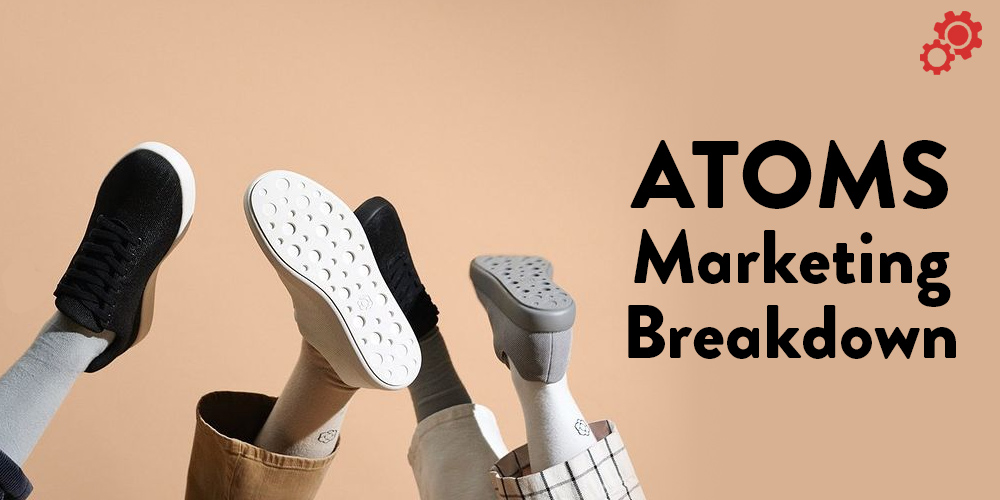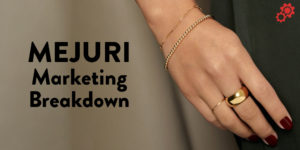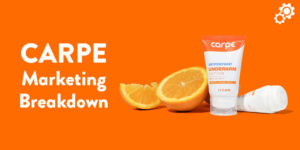I randomly stumbled across Atoms during a creative strategy call.
We were on a Zoom call discussing different ways to address pricing objections for Crossrope. After all, our unique jump rope sets range between $99 and $248.
That’s when someone brought up the ‘They’re Not Cheap’ ad from Atoms (more on this later). I was intrigued. As I usually do when I get intrigued by a brand, I went down a (deep) rabbit hole. I wanted to learn as much as I could about this New York based shoe brand taking on behemoths like Nike and Adidas.
Atoms was founded by husband-and-wife-duo Sidra Qasim and Waqas Ali who have one of the most inspiring entrepreneurial stories I’ve come across. Since launching Atoms in 2018 (their 3rd startup together), they’ve been making waves in the shoe industry with powerful storytelling and a willingness to go to atomic levels to create the perfect everyday shoe. With $16 million in funding, their future looks bright.
Let’s talk about the marketing strategies they’ve used to grow along the way.
Atom’s Marketing Tactics Overview:
- Be meaningfully different from the competition
- Focus on story first, product second
- Obsess over your customers
- Build your wait list organically (with some chai)
- Get your product into the hands of influential people
- Drive lifetime value with good-will and creativity
- Be bold with how you handle price objections
- Minimize friction for your shoppers
1. Be meaningfully different from the competition
For many brands, getting people to pay attention is incredibly challenging in today’s world.
To have a chance, you need to lean on differentiation. You need to find a way to stand out through your design, customer experience, and your marketing. If it’s good enough, your point of differentiation is what people will latch onto – it’s what they will talk about.
As Seth Godin says, ‘differentiate to succeed.’
“In a crowded marketplace, fitting in is failing. In a busy marketplace, not standing out is the same as being invisible.”
Seth Godin, Purple Cow
Atoms garnered attention from the moment they launched because they did something no other shoe brand had ever done: they offered shoes in quarter sizes.
In their obsession for crafting the most comfortable everyday shoe, they knew roughly 60% of people have a quarter-size difference between their right and left foot and that fit was one of the most important elements of building a comfortable shoe. While most shoe companies offer half sizes and full sizes, Atoms offers quarter sizes from 3.5 all the way to 15 (you’ll see nearly 48 different size options).
“We thought it would be challenging, and it wasn’t unchallenging, but the good thing was that many manufacturers were already starting to think about this,” Ali said. “Think about it, there has been almost no innovation in shoe making in the last 30 or 40 years.” He said they were happy to talk to Atoms because “we were the first and only company looking at shoes this way.”
Waqas Ali on TechCrunch
Logistically, here’s how it would work (pre-Covid): when you buy a pair of Atoms, you get to select up to three different sizes of the same shoe. You pay for one pair, but they ship you all three. When you receive the shoes, you can mix and match whichever sizes fit you best and then send the other shoes back. They’ve since stopped doing this because of COVID (they now have a Size Finder), but at the outset it was a very novel approach.
They’re the first brand to do this in the shoe market, but not the first brand to have success with it. Third Love is another example of a brand that has done well offering bras and undergarments in a wide range of sizes.
But this isn’t where the differentiation stops.
When you visit most shoe sites and click ‘Shop Shoes’, you get taken to a category page with dozens of shoe styles, with various models and colors to choose from.
Atoms only offers one single model – one single product page offering the current model they’re selling for the year (the Model 000 at the time of this writing). You can choose whether you want the Men’s or Women’s version, which of the five colors you want, and which of the 48 sizes you’d like. That’s it.

The shoes have no logos and have a simple minimalistic look. By stripping away all the variations, it allows them to focus on what they care about – offering a high quality shoe with features designed to enhance comfort and durability while offering a wide variety of sizes.
“We will make only one shoe design a year, but we want to make that really well.”
Sidra Qasim on TechCrunch
Here’s the point of all of this: when you do something meaningfully different, it gives people a reason to pay attention. It gives them a reason to talk about you.
Your key takeaways:
- Whether you’re launching a new product, new feature, or new marketing campaign – think about how you can do something meaningfully different from the competition.
- Consider what other competitors in your space are doing that’s considered ‘normal’ or ‘expected’ and think about how you can break that pattern and go all in on that feature. If everyone is selling white toilet paper, you know people will talk about the brand that sells black toilet paper.
- Figure out what you’re going to obsess over and go all in on that. For Atoms it was obsessing over the perfect fit and stripping away all the fancy variations.
2. Focus on story first, product second
The best brands and best products are powered by a great story.
“Many times what founders do is they make the product first and then try to figure out what the story is. The best products are stories first and then product second.”
Waqas on Startup Toronto Podcast
Atoms is all about storytelling and you’ll know this if you listen to any interview with Sidra or Waqas.
There’s the ‘entrepreneurs overcoming all odds’ story. There’s the ‘husband-and-wife duo’ story. There’s the ‘Atoms obsessing over their customers’ story. There’s the ‘sustainable manufacturing’ story. There’s the ‘we’re bigger than shoes’ story. All of these different story elements make Atoms a brand worth talking about.
It’s these stories you hear about when you listen to Waqas and Sidra on podcasts or read about them in interviews. It’s these stories that get written about and talked about and shared.
“At Atoms, we’re really focused on storytelling. It starts by telling the story about our products. We also want to go beyond that and share stories about what people are doing in their Atoms.”
Waqas on Vimeo interview
Through storytelling (and being meaningfully different), Atoms has generated nearly 20,000 backlinks and has been covered by numerous outlets including TechCrunch, Morning Brew, Forbes, and many others.

And like the best brands, you’ll see these stories told all throughout the Atoms marketing ecosystem. You’ll see it in their ad copy and imagery. You’ll see it on their social channels. You’ll see it on their website. You’ll see it in their email campaigns. It’s simply part of their DNA.

My favorite little examples of Atoms storytelling are sprinkled throughout their social channels (particularly Instagram and Twitter), which the founders themselves oversee. It’s an opportunity for them to share little snippets of the Atoms story while engaging with and enrolling their customers into the story.
“We have a very strong community on Twitter and that’s been really helpful for us. On Instagram and Twitter, we shared stories about how and why we are making our shoes, what kind of materials we’re using, and about our team behind the product.”
Sidra on Forbes
The point is this – stories spread. The most powerful result of their efforts: an 11-part spread on the Humans of New York channel, generating an insane amount of attention for the brand.
Your key takeaways:
- Whether you have a product or you’re just creating one, think about the story you want to tell. Make a list of the different story elements that make your brand what it is and consider how you are weaving those story elements through your marketing ecosystem.
- If people were to interview you, what stories would you tell about yourself, your brand, and your products? Know how to answer the question of why your brand exists.
- Read the book StoryBrand by Donald Miller if you want to learn more about storytelling.
3. Obsess over your customers
It’s hard to build a great product without obsessing over your customers and their needs.
While the concept of Atoms was still in its original phases, co-founders Waqas and Sidra created a document where they laid out what the world would look like and how their product would fit into this world. They shared this document and got feedback on their idea before ever creating the product.
In that document they laid out who their ideal customer would be.
“We thought a lot about who our ideal customer is – it could be an artist, curator at a museum, someone who works in a kitchen or wine shop, sound mixer, creative director, or Instagram designer. We even had a name for this ideal customer – the new creative.“
Waqas on Hack to Start Podcast
Advised by their mentors at YC, they spent a lot of time at Nike and Adidas stores speaking with customers and asking them what kind of shoes they were looking for, what their biggest pain points were, and collecting feedback that ultimately helped them shape the early version of Atoms.
“We researched how we could make everyday shoes for two years. We did interviews with our existing customers and sat inside of Nike retail stores observing user buying behaviors.”
Sidra on Forbes
They even moved to New York to be closer to their ideal customer.
“Our core focus for coming to New York was selling shoes and setting up Atoms in New York’s ecosystem. We’re building Atoms around the creative community. Our office is in Brooklyn’s Navy Yard because it’s an interesting and inspiring place. There are a lot of artists, creatives, designers, and dancers in Brooklyn.”
Sidra on Forbes
By knowing who their ideal customer was and what they truly cared about in their shoes, they were able to create a product that met their needs. That’s why, for example, there are no logos on the Atoms shoe. It’s because the new creative doesn’t want to signal too much about what brands they are supporting and don’t like the idea of someone using their feet as billboards.
Your key takeaways:
- Take some time to discover exactly who your ideal customers are. Then go find them and speak with them. Ask them questions, engage with them, and learn from them. You’ll get valuable feedback that will shape your product (and brand).
- Before going too deeply into ‘build mode’, write about the products and features you want to create in a document and share it with others. See if your ideas get people excited first. Map out who your ideal customer is and what their world would look like if they had your product.
4. Build your wait list organically (with some chai)
Atoms started with only 20 samples in a single shoe size.
While living in San Francisco, the duo started reaching out to their connections at YC and local San Francisco area. They wanted to give away their 20 samples in exchange for honest & brutal feedback on the product.
They invited people into their home for breakfast and chai and had deep discussions about what people truly cared about when it came to shoes.
“After we created our first product sample, we invited 20 people over to our home. We cooked them breakfast and made Pakistani chai. We gave them shoes and said, “Hey, this is what we’ve created. This is why we think they can become your ideal everyday shoes. Please wear these and give us your feedback.”
Sidra on Forbes
And while it didn’t happen intentionally, the word started to spread. People started sharing photos online and more and more people started requesting different sizes for themselves and their friends.
Since they didn’t have the manufacturing set up, they created a landing page with a Typeform capture and asked people to leave their name, email address, size and color they wanted along with questions about the current shoes they were wearing and for what use cases.
With every batch of samples they would improve the shoe and hand them out to more people for more feedback. In two months, their list grew to 10,000 people. By the time they were ready to launch, they had 45,000 people on their wait list. And it was all built organically.

“By the time we were ready to launch, 45,000 people had signed up for our mailing list. On the first day of sales our website crashed. And by the end of six months we’d sold 12,000 pairs of shoes.”
Sidra on HONY
What was never intended to be a marketing strategy at the outset ended up being a unique launch strategy for the brand we can all learn from. When you invite people to try your product in a human and authentic way, people open up to you. They feel like they’re part of something.
And they naturally want to tell others about it.
Your key takeaways:
- If you’re launching a new brand, product, or feature, consider how you can invite your ideal customers to try it privately. Make the experience unique and authentic and exclusive so they feel they’re part of something bigger and want to invite others.
- You don’t need to have everything in place in order to start building a wait list. Create a simple landing page with a form capture where you can send people to sign up to get notified.
5. Get your product into the hands of influential people
It’s every brand’s dream to get an influential person to rep their brand. It creates buzz and generates publicity for the brand that (usually) materializes into some meaningful traction, especially early on.
Often, for many brands, this happens by chance. But Atoms has taken a more proactive approach.
“We sent shoes to a lot of people we admired like Apple’s Jony Ive, Pixar’s Pete Docter, etc. They each sent back written notes telling us how much they loved the product. Build authentic relationships with people. Don’t hesitate to reach out, send an email, or send your product. You will see doors open for you.”
Sidra on Forbes
What I like about their approach is they didn’t just send samples to every influential person they knew. They found influential people who fit the profile of their ideal customer. Remember, they’re focused on building shoes for the ‘new creative’ – designers, artists, chefs, etc.
When you ship out a product to an influential person (or any person for that matter) and it shows that the individual was carefully selected – that you’ve chosen them for a reason – you get a much better response.
Eventually the shoes got into the hands of Alexis Ohanian, the founder of Reddit.
“The thing that I love about Atoms is that it isn’t just a different look, it’s a different feel. When I put on a pair for the first time, it was a totally different experience.”
Alexis Ohanian on Grit Daily
You can’t let your product get into the right hands by chance. Like Atoms, it’s important to be proactive in getting your product in the right hands. Intentionality matters. Relationships matter.
“Waqas and I put a lot of effort into genuinely reaching out to people, getting to know them, and thinking about how we can add value to them even if our offering is only our product.”
Sidra on Forbes
When you have influential people using your product, word naturally spreads. It also undoubtedly comes in handy when you’re trying to raise money. What’s interesting with Atoms is that many of the influential people who were using the product also became investors at some stage.
Your key takeaways:
- Getting your product into the hands of influential people can be needle-moving for any business, but it’s not easy. Focus on building the best product and only send it to those who actually fit your ideal customer profile – you’ll have a better chance of success.
- Start by making a list of all the influential people both within and outside of your network and start connecting. Like Sidra says, “don’t hesitate to reach out, send an email, or send your product” – the worst thing that can happen is no response.
- In every relationship you seek to build, think about how you can add value to someone’s life.
6. Drive lifetime value with good-will and creativity
Every brand thinks about customer lifetime value (or should).
With shoes, it’s an interesting game. Whether you need to replace a worn-out pair, want to add a new pair to your collection, or need a different kind of shoe (eg. for running), there are many reasons to buy more shoes.
But there are also an infinite number of options.
This is where the power of brand and differentiation come into play.
Most shoe brands have a large catalogue of shoes you can choose from. As we’ve seen, Atoms has one shoe – a single model they release once a year. They are so laser focused on a building the best shoe possible – a shoe that’s comfortable, that fits perfectly, that lasts – they’re banking on customers loving the shoes so much they’ll want to buy a new model each year.
But a good product can only take you so far. Incentive matters. Aside from selling accessories like socks and masks, Atoms has a unique way to bring customers back.
Once it’s time to replace your shoes, you can send your shoes back to the company and in exchange you will get a discount on your next pair. You’ll also play a part in improving the future version of an Atoms shoe.
The team at Atoms analyzes the insole pattern from your shoe and uses the data to improve the product. They then donate the pair of shoes you’ve returned to someone in need.
“Now Atoms is trying to build more commerce innovation to turn buyers into lifetime wearers. It’s working on a special pattern for the insole that will rub off based on where you put your weight. The idea is that when people send their old pairs in for a discount on the next, it can analyze that insole pattern to improve the shape of future models.”
TechCrunch 2018
This is a really clever way to create a multi-win scenario. By having your customers be a part of the creation process and allowing them to give back by donating their old shoes to someone in need, you create a sense of good-will that helps build loyalty with the brand. The discount helps too.
And it’s working. According to Waqas, 85% of first-time customers are coming back to purchase another pair.
Your key takeaways:
- Consider what incentives you can put in place to drive repeat purchases for your customers. Discounts help, but challenge yourself to go beyond that. Is there a good-will play you can make? Can a donation be made? Can your product be recycled? Make a list of all the options you have and see how each could be part of your brand story.
7. Be bold with how you handle price objections
I mentioned earlier that I first came across Atoms after it came up in discussion on a creative strategy call. We were talking about how to overcome price objection at Crossrope.
“Have you seen the ‘They’re Not Cheap’ ad?” one of our guys asked. So we pulled it up.

“Yes we could make Atoms cheaper. But if we did that, they’d be cheap.”
A pair of Atoms shoes cost about $129 (even more for select colors). Allbirds, one of their competitors, mostly sell for $95 and you can definitely get a nice pair of Nikes or Adidas for under $100 (like I do). So Atoms isn’t substantially more expensive, but it definitely fits in the premium category.
Any brand that sells anything that’s remotely “expensive” has the comment section of every ad stuffed with comments on price objection. Sometimes it’s fun to read through those on a Friday night.
But not many brands hit on price objection head on like Atoms. And it’s inspiring. Mind you, any move like this will be polarizing. if you want to go down a rabbit hole, just go check out the 1500+ comments they got when they posted this to their Instagram channel.

Whether you’re a fan of this ad or not, a move like this does a few things:
- It gets people talking – 1500+ comments on the post is proof alone, but the ad gets shared and talked about just like it did at our creative call. It’s interesting.
- It helps prospects justify their purchase – if you’re a prospective buyer and you’re hesitant to pull the trigger, an ad like this – with a reminder of all the things that go into the price – could get you over the fence.
- It helps with buyer’s remorse and gives customers a reason to evangelize the brand – we all feel a bit of buyer’s remorse when we spend a lot of money on something, sometimes to the point where we don’t want to talk about it (or are embarrassed to talk about it). An ad like this allows customers to point and say ‘this is why I bought them’ and stand behind the brand.
Your key takeaways:
- If you’re operating in the premium category and face price objections, consider what your version of the ‘They’re Not Cheap’ ad could look like. Even if you don’t use it, it’s a worthwhile exercise to write out your own reasons for why your product is expensive.
8. Minimize friction for your shoppers
When optimizing the shopping experience, it really comes down to minimizing friction for the consumer. You need to make it as easy and frictionless as possible for them to take the next step.
Think about Amazon’s 1-click buy button – you can go from landing on site to purchasing something with a single click. That’s the reason I end up with so many eBooks on my Kindle.
I’m always interested to see how DTC brands implement this stuff. In another breakdown I did of The Sill, they actually had a 1-click checkout option right from their navigation at one point.
For Atoms, it all starts by offering one shoe. This means consumers don’t have to think about what shoe they want – there’s only one model to choose from. So we skip the category page. In fact, most of their ads drive traffic straight to the product page.
Ad > product page > drawer cart > checkout
The main point of friction they needed to overcome was size selection. Whenever you’re doing something that’s different from the norm (like offering quarter sizes), it’s going to make consumers pause.
They introduced the Fit Finder tool to help consumers find the perfect fit. It takes less than a minute to complete and recommends the exact shoe size based on your age, foot structure, and even the size of other shoes you’ve worn from other brands. Once you’ve completed the quiz, the recommended size is automatically selected when you get to the product page. Pretty sweet.

Here’s another way they minimize friction: on the product page, you have the option to add accessories to your cart (socks, masks, etc.). But instead of having to click on each to go to the product page to select your size and colors (like some brands do), the consumer can make those quick selections all without leaving the PDP.

It’s obvious that Atoms’ obsession with the customer continues through to the site. They think through each and every step the consumer takes on their journey to becoming an Atoms customers.
Your key takeaways:
- Assess your marketing funnel for points of friction – where are shoppers getting stuck? Where are your primary bottle necks? Look to optimize those.
- User testing is a great way to identify points of friction that you may not be aware of. Have some strangers run through your site and see where they get stuck.
- Strive to minimize the steps needed to get from landing page to purchase. Note that the more of a ‘considered purchase’ your product is and the more education it requires, the more steps will be needed to complete the purchase.
Atoms: Marketing Summary
Atoms is on a mission to redefine shoes. With their laser focus on product, obsession with their customer, and unique storytelling approach, they have built a brand that’s worth talking about.
Now, with over $16M in funding at hand, they’ve got a bright yet challenging future ahead of them as the behemoths start paying attention. When asked what the future holds, Waqas said:
“The ultimate desire is to build Atoms into a company that matters. Most companies you see in the world, if they disappear, it does not matter. Someone else is making something that you need. We are continuously asking this question: How we can build a company that matters? It’s not just being able to make a great product, but how we can do it over and over again and how we can do better and better.”
Atoms – Meet the Founders
We’ll be watching.
Enjoyed this post? Sign up below to get notified when a new breakdown goes live –
✌




